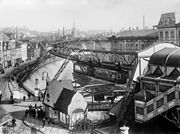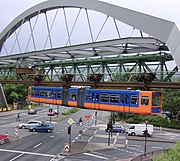Country: Germany
Distance: 1,047 km
Travel time: 7 days
On postcard: Wuppertal Schwebebahn
Wuppertal Schwebebahn or Wuppertal Floating Tram is a suspension railway in Wuppertal, Germany. Its full name is “Electric Highway Installation (Floating Tram), Eugen Langen System” (Anlage einer elektrischen Hochbahn (Schwebebahn), System Eugen Langen). Designed by Eugen Langen to be used in Berlin, the installation with elevated stations was built in Barmen, Elberfeld and Vohwinkel between 1897 and 1903, the first track opened in 1901. The Schwebebahn is still in use today as normal means of local public transport, moving 25 million passengers annually (2008).
The suspension railway travels along a route of 13.3 kilometres (8.3 mi), at a height of about 12 metres (39 ft 4 in) above the river Wupper between Oberbarmen and Sonnborner Straße (10 kilometres (6.2 mi)) and about 8 metres (26 ft 3 in) above the valley road between Sonnborner Straße and Vohwinkel (3.3 kilometres (2.1 mi)). At one point the railway crosses the A46 motorway. The entire trip takes about 30 minutes. The Schwebebahn operates within the VRR transport association and accepts tickets issued by the VRR companies.
History
The Wuppertal Schwebebahn had a forerunner: in 1824, Henry Robinson Palmer of England presented a railway system which differed from all previous constructions. It was basically a low single-rail suspension railway on which the carriages were drawn by horses. Friedrich Harkort, a Prussian industrial entrepreneur and politician, loved the idea. He saw big advantages for the transportation of coal to the early industrialised region in and around the Wupper valley. Harkort had his own steel mill in Elberfeld; he built a demonstration segment of the Palmer system and set it up in 1826 on the grounds of what is today the Wuppertal tax office. He therefore tried to attract public attention to his railway plans.
On 9 September 1826, the town councillors of Elberfeld met to discuss the use of a “Palmer’s Railway” from the Ruhr region, Hinsbeck or Langenberg, to the Wupper valley, Elberfeld, connecting Harkort's factories. Friedrich Harkort inspected the projected route with a surveyor and a member of the town council. The plans never went ahead, due to protests from the transport branch and owners of mills that were not on the routes.
In 1887 the cities of Elberfeld and Barmen formed a commission for the construction of an elevated railway or Hochbahn. In 1894 they chose the system of the engineer Eugen Langen of Cologne, and in 1896 the order was licensed by the City of Düsseldorf. In 2003, the Rhine Heritage Office (Rheinische Amt für Denkmalpflege des Landschaftsverbandes Rheinland or LVR) announced the discovery of an original section of the test route of the Wuppertal Schwebebahn.
Construction on the actual Wuppertal Schwebebahn began in 1898, overseen by the government’s master builder, Wilhelm Feldmann. On 24 October 1900, William II, German Emperor participated in a monorail trial run.
In 1901 the railway came into operation. It opened in sections: the line from Kluse to Zoo/Stadion opened on 1 March, the line to the western terminus at Vohwinkel opened on 24 May, while the line to the eastern terminus at Oberbarmen did not open until 27 June 1903. Around 19,200 tonnes of steel were used to produce the supporting frame and the train stations. The construction cost 16 million Goldmark. Since its first opening, the railway has closed once due to severe damage from World War II, but managed to open as early as 1946.
Construction of Wuppertaler Schwebebahn, 1900
Station Werther Brücke 1913
A 1977 Schwebebahn, crossing an intersection
Current modernisation
The Wuppertal Schwebebahn nowadays carries up to 82,000 passengers a day through the city. Since 1997, the supporting frame has been largely modernised, and a lot of stations have been reconstructed and brought technically up to date. The “Kluse” station, at the theatre in Elberfeld, had been destroyed during the Second World War; this too was reconstructed during the modernisation. Work was planned to be completed in 2001; however a serious accident took place in 1999 which left five people dead and 47 injured. This, along with delivery problems, meant that the completion date was delayed. In recent years (2004), the cost of the reconstruction work has increased from €380 million to €480 million.
Since 2004, many of the railway stations have been fitted with CCTV cameras.
The renovation is projected to be completed by 2011. On 15 December 2009 the Schwebebahn temporarily suspended its operations for safety concerns; several of the older support structures needed to be renewed, - a process that was completed on 19 April 2010.
Technology
The tram wagons are suspended from a single rail built underneath a supporting steel frame. The cars hang on wheels which are driven by an electric motor operating at 600 volts DC, fed from an extra rail.
The supporting frame and tracks are made out of 486 pillars and bridgework sections. The termini at each end of the line also serve as train depots and reversers.
The current fleet consists of twenty-seven two-car trains built in the 1970s. The cars are 24 metres long and have 4 doors. One carriage can seat 48 with approximately 130 standing passengers. The top speed is 60 km/h and the average speed is 27 km/h.
The Kaiserwagen (Emperor's car), the original train used by Emperor Wilhelm II during a test ride on 24 October 1900, is still operated on scheduled excursion services, special occasions and for charter events.

















0 коммент.:
Отправить комментарий